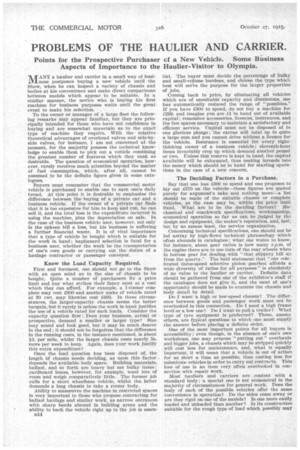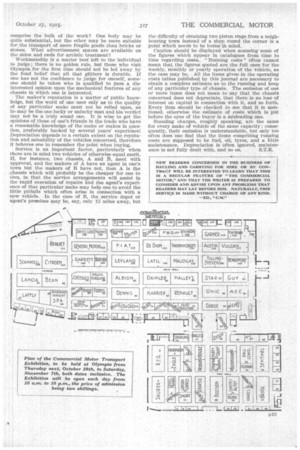PROBLEMS OF THE HAULIER AND CARRIER.
Page 12

Page 13

If you've noticed an error in this article please click here to report it so we can fix it.
Points for the Prospective Purchaser of a New Vehicle. Some Ihisiness Aspects of Importance to the Haulier-Visitor to Olympia.
MANY a haulier and carrier in a small way of business postpones buying a new vehicle until the Show, when he can inspect a variety of chassis and bodies at his convenience and make direct comparisons between models which appear to be suitable. In a similar manner, the novice who is buying his first machine for business purposes waits until the great event to make his selection.
To the owner or manager of a large fleet the following remarks may appear familiar, but they are principally intended for those who have not confidence in buying and are somewhat uncertain as to the exact type of machine they require. With the relative theoretical advantages of overhead valves and side-byside valves, for instance, I am not concerned at the moment, for the majority possess the technical knowledge to enable them to pick out a vehicle combining the greatest number of features which they rank as desirable. The question of economical operation, however, rarely receives much attention beyond the matter of fuel consumption, which, after all, cannot be assumed to be the definite figure given in some catalogues.
Buyers must remember that the commercial motet' vehicle is purchased to enable one to earn one's daily bread. At this point it is desirable to emphasize the difference between the buying of a private car and a business vehicle. If the owner of a private car finds that it is too expensive for him to keep and run, he can sell it, and the total loss is the expenditure incurred in using the machine, plus the depreciation on sale. In the case of the business vehicle user, however, not only is the upkeep bill a loss, but his business is suffering a further financial waste. It is of vital importance that a type of vehicle be bought which is suitable for the work in hand ; haphazard selection is fatal for a business user, whether the work be the transportation of one's own goods or carrying out the duties of a • haulage contractor or passenger conveyor.
Know the Load Capacity Required.
First and foremost, one should not go to the Show with an open mind as to the size of chassis to be bought. Quite a number of purchasers fix a price limit and buy what strikes their fancy most at a cost which they can afford. For example, a 1-tonner complete may cost £300 and another make of vehicle rated at 30 cwt. may likewise cost £300. In these circumstances, the larger-capacity chassis seems the better bargain, but it rarely is unless the work in hand justifies the use of a vehicle rated for such loads. Consider the capacity question first : Does your business, actual or prospective, demand a smaller or larger type? Size may sound and look good, but it may be much dearer in the end ; it should not be forgotten that the difference In the running costs, in the instance mentioned, is about id. per mile, whilst the larger chassis costs nearly 5s. more per week to keep. Again, does your work justify this extra expenditure?
Once the load question has been disposed of, the length Of chassis needs deciding, as upon this factordepends the available body space. Building materials, ballast, and so forth are heavy but not bulky items cardboard boxes, however, for example, want lots of room and weigh comparatively little. The former job calls for a short wheelbase vehicle, whilst the latter demands a long chassis to take a roomy body.
Ability to manoeuvre the machine in restricted spaces Is very important to those who propose contracting for ballast haulage and similar work, as narrow entrances with sharp be,nds abound in building areas and the ability to back the vehicle right up to the job is essen n14 tial. The buyer must decide the percentage of bulky and small-volume burdens, and choose the type which best will serve the purpose for the larger proportion of jobs.
Coming back to price, by eliminating all vehicles which are of unsuitable capacity and dimensions, one has automatically reduced the range of " possibles." If you have £300 to spend, do not buy a machine for £290, and imagine you are kl-in hand out of available capital; remember accessories, licences, insurances, and the few spares necessary to maintain a satisfactory and efficient service. Capital must not be disposed of in one glorious plunge; the extras will total up to quite a large sum and you cannot drive without a licence for the vehicle. Insurance is essential for every rightthinking owner of a business vehicle; eleventh-hour items invariably crop up which demand another pound or two. Unless this reserve is kept in hand, the capital available will be exhausted, thus making inroads into the money which should be in hand for starting operations in the case Of a new concern.
The Deciding Factors in a Purchase.
Say that one has £300 to spend and one proposes to lay out £270 on the vehicle—these figures are quoted purely for argument's sake and nothing more—a list should be made of the suitable chassis or complete vehicles, as the case may be, within the price limit fixed. What are to be the deciding factors? Mechanical and coachwork specifications, workmanship, economical operation so far as can be judged by the design and equipment, the maker's reputation, and, last, but by no means least, the service organization.
Concerning technical specifications, one should not be led astray by high-flown technical phraseology which often abounds in catalogues; what one wants to know, for instance, about gear ratios is how many r.p.m. of the engine there are to one turn of the rear wheels when in bottom gear for dealing -with "that slippery hill up from the quarry." The bald statement that " our celebrated three-speed selective pinion gearbox affords a wide diversity of ratios for all purposes" is absolutely of no value to the haulier or carrier. Definite data should be gathered from one of the exhibitor's staff if the catalogue does not give it, and the most of one's opportunity should be made to examine the chassis and body detail by detail.
Do I want a high or low-speed chassis? The difference between goods and passenger work must not be overlooked in this connection. Do I need a high frame level or a low one? Do I want to pull a trailer? What type of tyre equipment is preferred? These, among others, are typical_ questions to which one must supply the answer before placing a definite order.
One of the most important points for all buyers is accessibility ; even though, in the absence of one's own workshops, one may propose " putting out" overhauls and bigger jobs, a chassis which may be stripped quickly will cost less for maintenance, and, what is equally important, it will mean that a vehicle is out of action for as short a time as possible, thus costing less for substitute vehicles in order to carry out contracts. This loss of use is an item very often overlooked in connection with repair work.
Most .hauliers and carriers are content with a standard body ; a special one is not economical in the majority of circumstances for general work. Does the body of each of the possible vehicles offer the same convenience in operation? Do the sides come away or are they rigid on one of the models? Is one more easily loaded and unloaded than another? Is its construction suitable for the rough type of load which possibly may
comprise the bulk of the work? One body may be quite substantial, but the other may be more suitable for the transport of more fragile goods than bricks or stones. What advertisement spaces are available on the sides and ends for artistic treatment?
Workmanship is a matter best left to the individual to judge; there is no golden rule, but those who visit Olympia. for the first time should not be led away by the fond belief that all that glitters is durable. If one has not the confidence to judge for oneself, someone should be taken who is qualified to pass _a disinterested opinion upon the mechanical features of any chassis in which one is interested.
The maker's reputation is a matter of public knowledge, but the word of one user only as to the quality of any particular make must not be relied upon, as he may be the one lucky or unlucky man and his verdict may not be a truly sound one. It is wise to get the opinions of those of one's friends in the trade who have a reasonable knowledge of the'make or makes in question, preferably backed by several years' experience: Depreciation depends to a certain extent on the reputation and saleability of the vehicles concerned, therefore it behoves one to remember the point when buying.
Service is an important factor, particularly when there are in mind two vehicles of otherwise equal merit. If, for instance, two chassis, A and B, meet with approval, and the makers of A have an agent in one's town but the makers of B have not, then A is the ..chassis which will probably be the cheaper for one to Own, in that the service arrangements will assist in the rapid execution of repairs and the agent's experience of that particular make may help one to avoid the little pitfalls which often arise in connection with a new vehicle. In the case of B, the service depot or agent's promises may be, say, only 15 miles away, but the difficulty of obtaining two piston rings from a neighbouring town instead of a shop round the corner is a point which needs to be borne in mind. '
Caution should be displayed when scanning some of the figures which appear in catalogues from time to time regarding costs. "Ruining costs" often cannot mean that the figures quoted are the full ones for the weekly, monthly or yearly operation of the vehicle, as the case may be. All the items given in the operating costs tables published by this journal are necessary to obtain a complete estimate as to the running and keep of any particular type of chassis. The omission of one or more items does not mean to say that the chassis concerned does not depreciate, that there is no loss of interest on capital in connection with it, and so forth. Every item should be checked to see that it is mentioned, otherwise the estimate of costs which is put before the eyes of the buyer is a misleading one.
Standing charges, roughly speaking, are the same for every make of vehicle of the same capacity ; consequently, their omission is understandable, but only too often does one find that the items comprising running costs are supposed to be fuel, oil, tyres, and a little maintenance. Depreciation is often ignored, mainten ance is not fully dealt with, and so on. S.T.R.




























































